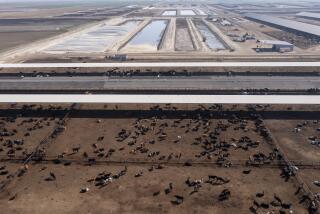Rural Income Growth Exceeds That of Urban
- Share via
WASHINGTON — The good news for farmers and others living in rural America is that their incomes are growing faster than those in urban areas. The bad news is that they still lag those in the cities and suburbs.
After declining 0.7% during the 1990-91 recession, rural per capita income rebounded 2.2% in 1992, 0.9% in 1993 and 2.8% in 1994, the final year in the Agriculture Department study.
As a result, income was $16,964 in 1994, up from $16,117 at the beginning of the decade.
At the same time, metropolitan area income growth fell 1.4% during the recession and then edged up just 1.4% in 1992, 0.6% in 1993 and 1.6% in 1994.
But despite faster growth, the per capita income of farmers and others living in the country trailed metropolitan residents, whose 1994 per capita income was $22,882. That’s $5,918--or 34%--more.
Still, the gap is narrowing. “During times of prosperity, there tends to be a convergence,” department statistician John Angle explained in an interview.
Per capita income is defined as total income--earnings, income from capital holdings including dividends, interest and rental payments and government transfers such as Social Security and Medicare--divided by population.
Rural area income growth in the early 1990s was widespread, Angle writes in the department’s current issue of Rural Conditions and Trends.
But he says the highest income growth--1.43% annually--was in counties that had widespread manufacturing activity. The slowest growth--0.89% a year--was in counties where farming predominated and which had experienced unusually strong 2.03% annual growth during the 1980s.
Rural per capita income varies only moderately among regions, Angle says. In 1994, rural per capita income was highest in the North at $18,028 and lowest in the South, at $15,905.
That represents 1% average annual growth in the North and 1.73% in the South.
Elsewhere, rural per capita income was up 1.26% to $17,598 in the central region and up 0.72% to $17,334 in the West.
In metropolitan areas, incomes averaged $24,652 in the North, $23,368 in the central region, $22,320 in the West and $15,905 in the South.
“Rural areas are experiencing widespread population growth and improved economic performance during the first half of the 1990s,” concludes Peggy Cook, who edited the 72-page report published by the department’s Economic Research Service.
She says it provides further credence to the argument that rural America as a whole is undergoing an economic and population revival.
Other indicators of economic performance show the rural economy performing considerably better in the first half of the 1990s than in the 1980s.
Average annual employment growth climbed to 1.6% annually during the first half of this decade, compared to 0.9% in the prior 10 years. At the same time, annual average unemployment declined to 7.7% from 8.8% in the 1980s.
Still, the overall jobless rate for the nation in 1995 was just 5.6%.
The report also notes that despite income growth, the poverty rate rose to 16.4% in 1994, from 15.7% in 1989. But it was 17.3% in 1993, suggesting the upward trend since 1989 may have slowed or reversed.
More to Read
Get the L.A. Times Politics newsletter
Deeply reported insights into legislation, politics and policy from Sacramento, Washington and beyond. In your inbox twice per week.
You may occasionally receive promotional content from the Los Angeles Times.








